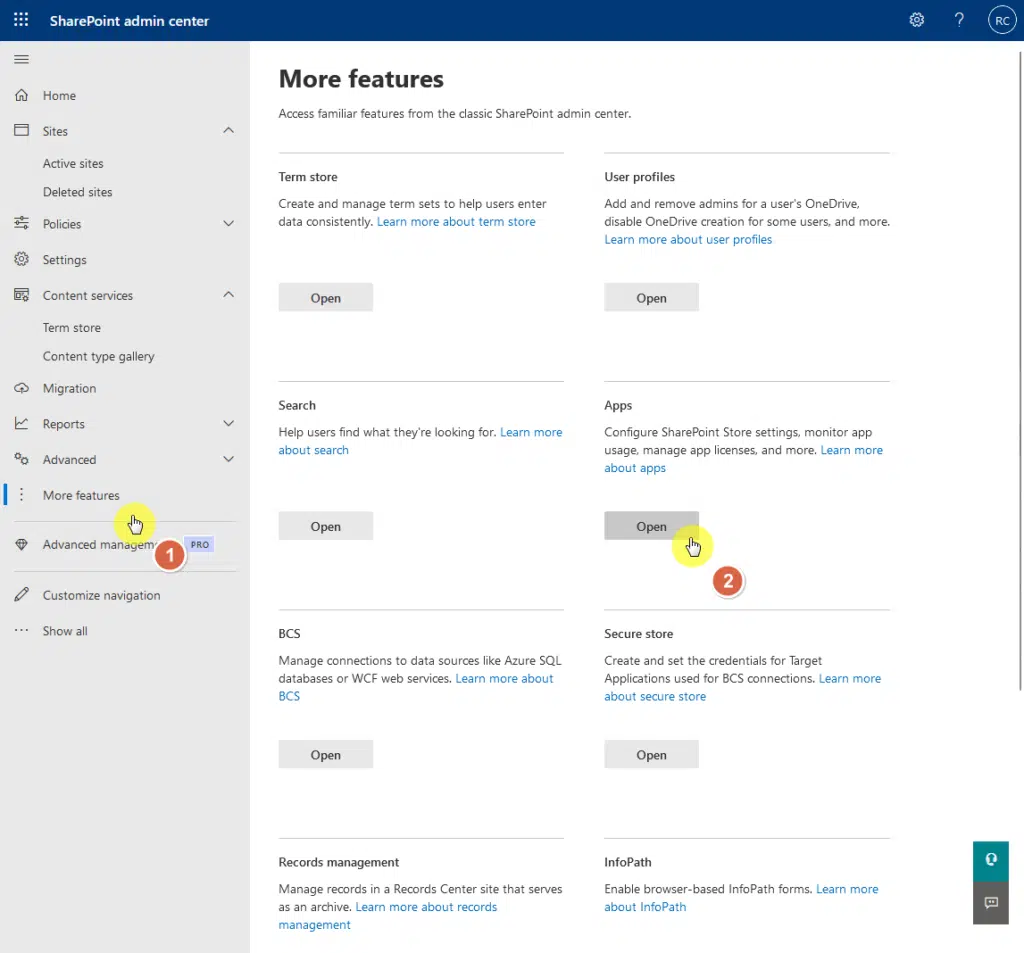Last Updated on June 29, 2024
Confused about the different app catalogs?
In this guide, I will walk you through the differences between the tenant app catalog and the site collection app catalog.
Let’s get started.
Table of Contents:
App catalogs in SharePoint are special libraries that store and manage custom apps for your organization.
They allow administrators to deploy, update, and manage apps centrally. 😎
Here’s a brief overview of the two main types:
- Tenant app catalog: This is a central repository for all custom apps available to every site collection in your SharePoint tenant.
- Site collection app catalog: This catalog is specific to a particular site collection, allowing apps to be managed and deployed at a more localized level.
Setting up and maintaining these catalogs requires administrative permissions and only through management tools.
Examples are:
- SharePoint Online Management Shell
- PnP PowerShell
- CLI for Microsoft 365
These app catalogs are vital for organizations using SharePoint as they provide a streamlined way to handle custom solutions.
They help ensure apps are managed securely and are accessible only to intended users.
Sign up for exclusive updates, tips, and strategies
What is the tenant app catalog?
This catalog is a centralized library in SharePoint Online used to store and manage apps for the entire organization.
Basically, it allows administrators to deploy apps that are available across all site collections in the tenant.
Here’s a brief overview:
- Centralized management: All apps are stored in one location and managed by tenant global administrators.
- Wide accessibility: Apps in the tenant app catalog can be accessed by all site collections.
- Consistent governance: Ensures that apps meet organizational standards before deployment.
The tenant app catalog simplifies app management by providing a single point for updates and governance.
It’s ideal for deploying solutions that need to be consistently available across multiple site collections.
In a way, this catalog helps maintain uniformity and security, enforcing compliance and standards on all apps deployed from it.
What is the site collection app catalog?
The site collection app catalog is a specialized library for managing apps within a specific site collection in SharePoint Online.
It allows site collection administrators to deploy and control apps independently from the central tenant app catalog.
Here’s a brief overview:
- Localized control: Allows site collection administrators to manage apps specific to their site collection.
- Site-specific solutions: Apps deployed here are only available within the designated site collection.
- Development flexibility: Ideal for testing and deploying apps in a controlled, localized environment.
This catalog is useful for departments or projects needing custom solutions without affecting the entire organization.
That’s because it allows site collection administrators to manage their apps and updates independently.
This catalog is particularly beneficial during the development and testing phases, as it isolates changes to specific site collections.
What are their key differences?
Let’s go over their three main differences:
Scope of deployment
The scope of deployment for app catalogs in SharePoint determines where and how apps are accessible and managed.
Here’s a brief overview:
- Tenant app catalog: Apps are deployed across all site collections in the tenant.
- Site collection app catalog: Apps are deployed only within a specific site collection.
The tenant app catalog provides a centralized approach, with easier governance but requires higher-level administrative control.
In contrast, the site app catalog offers localized control — customizations don’t affect the broader environment.
Choosing between these options depends on whether you need widespread accessibility or more targeted, site-specific deployments.
Control and permissions
Control and permissions are key factors in managing app catalogs in SharePoint.
That’s because they determine who can deploy, update, and manage apps within the organization.
Here’s a brief overview:
- Tenant app catalog: Managed by tenant global administrators with permissions to control organization-wide app deployment.
- Site collection app catalog: Managed by site collection administrators after initial setup by tenant global administrators.
The tenant app catalog ensures that only authorized personnel can deploy and manage apps across the entire tenant.
The site collection app catalog gives site collection administrators the flexibility to handle apps relevant to their specific site collection.
⚠️ Note: This means that tenant global administrators must initially grant permissions and set up the app catalog before it can be managed locally.
Use cases
These catalogs each serve distinct purposes within SharePoint, depending on the needs of the organization.
Here are some practical use cases for each type of catalog.
Tenant app catalog:
- Organization-wide applications: Use for apps that need to be accessible across all site collections.
- Standardized branding: Deploy branding elements like headers and footers for consistency.
- Global tools: Implement tools such as company-wide directories or news feeds that everyone needs.
Site collection app catalog:
- Department-specific solutions: Deploy apps tailored to the needs of individual departments or projects.
- Development and testing: Use for developing and testing apps in a controlled environment before wider deployment.
- Localized Customizations: Allow departments to manage their own apps without affecting the broader organization.
Choosing the right app catalog depends on whether you need broad organizational access or localized control.
Setup and Management
Now let’s move over to the setup and management of these catalogs.
Creating a Tenant App Catalog
Creating a tenant app catalog in SharePoint Online is a straightforward process.
Open the SharePoint admin center from the Microsoft 365 admin center:

⚠️ Note: You can open the Microsoft 365 admin center from any page in Microsoft 365 via app launcher > admin.
In the SharePoint admin center, go to more features > open button for the apps option.
Like this:

In the SharePoint modern experience, it’s likely that you would already see a ready-to-go tenant app catalog here.
In the past, there was a create a new app catalog site button where you can enter the required information.
Anyway, in the new experience, you can easily access features from the classic experience under the more features page:

You need to ensure that the tenant global administrators have the appropriate permissions to manage this catalog.
Regularly update and monitor the apps within this catalog to maintain security and functionality across the organization.
Creating a Site Collection App Catalog
Unfortunately, creating a site collection app catalog doesn’t use the interface in SharePoint (unlike the previous one).
You need to open the Windows PowerShell here to connect to your SharePoint tenant first and create the app catalog.
Like this:
Connect-PnPOnline -Url https://<tenant>-admin.sharepoint.com -Interactive
Add-PnPSiteCollectionAppCatalog -Site https://<your-site-collection-url>Verify the creation by checking the specified site collection for the “Apps for SharePoint” library.
⚠️ Note: Make sure that you have the necessary tenant global administrator permissions before beginning the process.
The site collection app catalog setup allows site collection administrators to manage apps within their specific site collection.
Pros and Cons
How about the pros and cons of each catalog?
Tenant App Catalog
The tenant app catalog offers several benefits and drawbacks for managing apps in SharePoint Online.
Pros:
- Centralized management: All apps are stored and managed from a single location.
- Wide accessibility: Apps are available across all site collections within the tenant.
- Consistent governance: Ensures all apps meet organizational standards.
- Simplified updates: Updating apps centrally ensures all site collections use the latest version.
Cons:
- Less flexibility: Limited to organization-wide deployment, restricting site-specific customizations.
- Higher administrative control required: Requires Tenant Global Administrators for setup and management.
- Potential for user confusion: All users see the same apps, which may not be relevant to everyone.
Choosing the tenant app catalog means opting for centralized control and easier management but at the cost of flexibility.
It’s a trade-off between broad accessibility and the ability to cater to specific site collection needs.
Regular monitoring and updates are important to maintain the integrity and security of the apps deployed through this catalog
Site Collection App Catalog
The site collection app catalog offers unique benefits and some limitations for managing apps within specific site collections.
Pros:
- Localized control: Allows site-specific management and customization of apps.
- Flexibility: Ideal for development, testing, and departmental solutions.
- Isolated updates: Changes in one site collection do not impact others.
- Reduced risk: Limits the impact of issues to a single site collection.
Cons:
- Higher security risk: Localized control can lead to inconsistent security practices.
- Complex management: Managing multiple site-specific catalogs can be more complex.
- Increased storage needs: Multiple app catalogs can lead to redundant storage.
- Version conflicts: Different versions of the same app across site collections can cause confusion.
The flexibility comes with increased complexity and potential security risks.
Admins must ensure consistent security practices and efficient management to avoid issues like version conflicts.
Regular audits and updates can help maintain the integrity and functionality of apps within these localized catalogs.
👉 Related: How to View SharePoint Online Audit Logs: Beginner’s Guide
Practical Scenarios
So when is the best time to use either of these catalogs?
When to use the tenant app catalog
As I explained above, this catalog is best suited for those requiring organization-wide app deployment and centralized management.
Here are some ideal situations:
- Uniform solutions: When deploying apps like headers, footers, or branding elements that need to be consistent across all site collections.
- Global tools: For tools such as employee directories, company news feeds, or any app that should be accessible to everyone in the organization.
- Centralized updates: When you need to manage and update apps centrally so that all site collections use the latest versions.
- Organization-wide policies: When enforcing compliance and security standards across all deployed apps.
It simplifies app management by allowing updates to be pushed centrally, reducing the risk of outdated or inconsistent apps.
This centralized approach also ensures that all apps comply with organizational policies for security and governance.
When to use the site collection app catalog
Once again, this app catalog is ideal for scenarios that require localized control and site-specific customizations.
Here are some ideal situations:
- Department-specific solutions: When deploying apps tailored to the needs of individual departments or projects.
- Development and testing: For developing and testing apps in a controlled environment before wider deployment.
- Localized customizations: When departments need to manage their own apps without affecting the entire organization.
- Isolated updates: To manage updates and versions of apps specific to a site collection, reducing broader impacts.
This has two particular benefits here:
- Minimizes the risk of changes affecting other parts of the organization
- Allows for specialized solutions without the need for tenant-wide deployment
However, it’s important to ensure proper governance and security practices when using site collection app catalogs.
Final Recommendations
Choosing between these catalogs depends on your organization’s needs and the level of control required.
Here are the final recommendations:
- Use the tenant app catalog: When you need centralized management, uniform app deployment, and organization-wide access.
- Use the site collection app catalog: When you need localized control, site-specific customizations, and isolated development environments.
The tenant app catalog is best for large organizations for consistent governance and easy updates across multiple site collections.
The site collection app catalog is ideal for departments or projects requiring flexibility and control over their specific app deployments.
Anyway, got any questions about the tenant app catalog vs the site collection app catalog? Let me know.
For any business-related queries or concerns, contact me through the contact form. I always reply. 🙂


Great article. This article was the key to help me find the difference between the two catalogs. My admin created an app catalog for me in a site collection as a sandbox and I was concerned I was going to deploy my test app across the organization when deploying it. Then I saw you put this:
“Verify the creation by checking the specified site collection for the “Apps for SharePoint” library.”
That one sentence was the key. Thanks again!